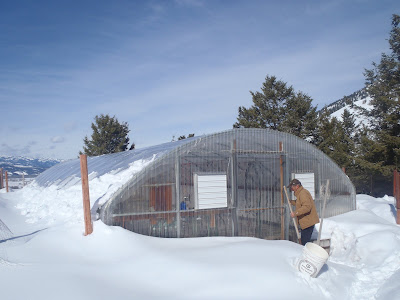I wrote this entry up about a week ago after walking around my house just observing the existing conditions. This is an essential, often overlooked opportunity to plan for a good design.
In the Tetons, heat is everything. As spring slowly comes to Jackson, giant piles of snow begin receding, exposing the sleeping earth below them. Buried equipment, chairs, and even forgotten beer bottles all come out of the snow, exposed for the first time in 6 months. It is here, in the melting snow that heat and solar radiation perform their handiwork.
The snow recedes from south facing areas first, especially near buildings and other dark structures. Last May Spencer and I learned just how much of an affect this has on snow while climbing up the Skillet Glacier on Mount Moran. Whenever we ventured too close to a rock wall we would abruptly sink several feet down in the snow, often up to our chest or even neck. The thermal mass of the rock had radiated heat downward below the snow surface, making it rotten.
As I walk around my house, the location for my garden will be the south wall of the garage. The full sun it receives has already melted some of the soil, so I will be able to plant in it with just a little preparation.

At the Mountain Meadows Garden, I’ve been working to speed up snowmelt in the garden by throwing used soil on the snow. This decreases the albedo or reflectivity of the snow. As the soil absorbs solar radiation the snow heats up more quickly than normal, and causes it to melt irregularly, forming a jagged landscape of dirty snow spires.

Insulation is also of key importance in Teton gardening. Today I was moving gravel that I had been storing outside on flattened cardboard, and noticed that dozens of plants had sprouted beneath it. The small stones and paper had acted like a blanket over the soil, prompting the seeds to germinate or awoken dormant roots, which sent up fresh shoots.
The short, difficult growing season in Jackson demands the attention of permaculture design in order to be successful. Proper site design to maximize free benefits of nature combined with appropriate technology such as greenhouses, hoop houses, cold frames, and row cover will allow for a bounty of local food.


























